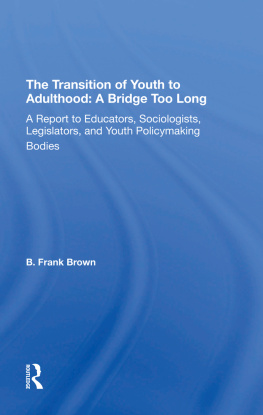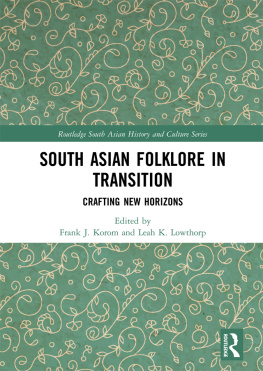B. Frank Brown - The Transition Of Youth To Adulthood: A Bridge Too Long
Here you can read online B. Frank Brown - The Transition Of Youth To Adulthood: A Bridge Too Long full text of the book (entire story) in english for free. Download pdf and epub, get meaning, cover and reviews about this ebook. year: 2019, publisher: Routledge, genre: Home and family. Description of the work, (preface) as well as reviews are available. Best literature library LitArk.com created for fans of good reading and offers a wide selection of genres:
Romance novel
Science fiction
Adventure
Detective
Science
History
Home and family
Prose
Art
Politics
Computer
Non-fiction
Religion
Business
Children
Humor
Choose a favorite category and find really read worthwhile books. Enjoy immersion in the world of imagination, feel the emotions of the characters or learn something new for yourself, make an fascinating discovery.
- Book:The Transition Of Youth To Adulthood: A Bridge Too Long
- Author:
- Publisher:Routledge
- Genre:
- Year:2019
- Rating:5 / 5
- Favourites:Add to favourites
- Your mark:
- 100
- 1
- 2
- 3
- 4
- 5
The Transition Of Youth To Adulthood: A Bridge Too Long: summary, description and annotation
We offer to read an annotation, description, summary or preface (depends on what the author of the book "The Transition Of Youth To Adulthood: A Bridge Too Long" wrote himself). If you haven't found the necessary information about the book — write in the comments, we will try to find it.
The Transition Of Youth To Adulthood: A Bridge Too Long — read online for free the complete book (whole text) full work
Below is the text of the book, divided by pages. System saving the place of the last page read, allows you to conveniently read the book "The Transition Of Youth To Adulthood: A Bridge Too Long" online for free, without having to search again every time where you left off. Put a bookmark, and you can go to the page where you finished reading at any time.
Font size:
Interval:
Bookmark:
Established by the Charles F. Kettering Foundation

52 Vanderbilt Avenue, New York, NY 10017
2 Park Square, Milton Park, Abingdon, Oxon OX14 4RN
Product or corporate names may be trademarks or registered trademarks, and are used only for identification and explanation without intent to infringe.
National Commission on Youth.
The transition of youth to adulthood: a bridge too long.
1. Youth policyUnited StatesAddresses, essays, lectures. 2. Conflict of generationsAddresses,
essays, lectures. 3. AdulthoodAddresses, essays, lectures.
I. Title.
HQ796.N3133 1980 301.43'15 79-20049
- Part 1
Transition of Youth - Part 2
Needs of Youth - Part 3
Assessing Youth Policy - Part 4
Evolving Youth Policy
- Part 1
Transition of Youth - Part 2
Needs of Youth - Part 3
Assessing Youth Policy - Part 4
Evolving Youth Policy
Director, Educational Relations
American Telephone & Telegraph Company
New York, New York
Professor, Department of Human Development and Family Studies
Cornell University
Ithaca, New York
Professor, Department of Sociology
University of Chicago
Chicago, Illinois
Vice President, Corporate Strategy
Armco Steel Corporation
Middletown, Ohio
Director, Department of Education
AFL-CIO
Washington, D.C.
Associate Executive Director
National Manpower Institute
Washington, D.C.
Chairman, The Gallup Poll
American Institute of Public Opinion
Princeton, New Jersey
Director, Educational Policy Research Center
Stanford Research Institute
Menlo Park, California
Superintendent
Denton Independent School District
Denton, Texas
Congressman
Sixth District, Connecticut
Washington, D.C.
Executive Assistant to the Superintendent
Public Schools of the District of Columbia
Washington, D.C.
Coordinator
National Collaboration for Youth
Washington, D.C.
Vice President and Special Assistant to the President
Charles F. Kettering Foundation
Dayton, Ohio
Dr. David L. Manning. To him went the task
of pulling together the Commission's ideas, organizing
the tapes, compiling the notes, and distilling two years
of information into written form.
Director
National Commission on Youth
Font size:
Interval:
Bookmark:
Similar books «The Transition Of Youth To Adulthood: A Bridge Too Long»
Look at similar books to The Transition Of Youth To Adulthood: A Bridge Too Long. We have selected literature similar in name and meaning in the hope of providing readers with more options to find new, interesting, not yet read works.
Discussion, reviews of the book The Transition Of Youth To Adulthood: A Bridge Too Long and just readers' own opinions. Leave your comments, write what you think about the work, its meaning or the main characters. Specify what exactly you liked and what you didn't like, and why you think so.








